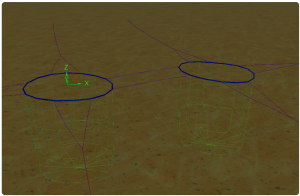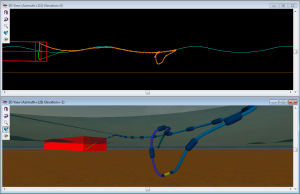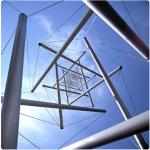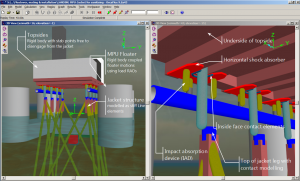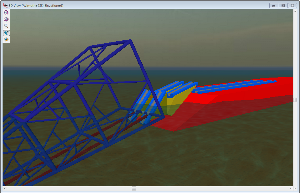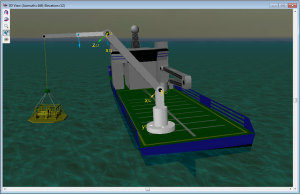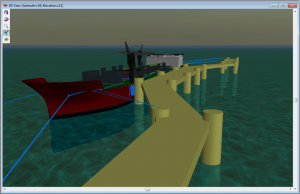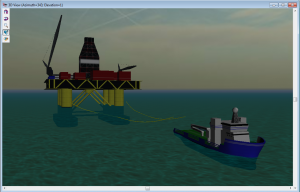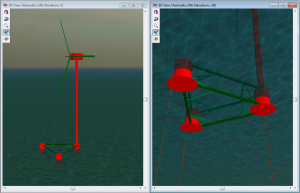OrcaFlex is primarily used in the offshore oil and gas industry, typically for installation analysis and in-place design of riser and mooring systems, pipelay analysis, field construction, etc., as well as being widely used in the oceanographic community. However, OrcaFlex is an extremely versatile package, and over the years we have seen it used for the global dynamic analysis of a wide variety of applications. Starting what will be an occasional series of blog postings about less common applications for OrcaFlex, we kick-off with a summary of these.
Aquaculture
Such systems include traditional fish farms (with multiple cells), vertical mussel farms and compliant horizontal mesh systems for seaweed cultivation. All have net or mesh type structures which are typically connected to moored rigid or semi-rigid boundaries. The moorings of the system are also analysed as are any inter-cell connections.
Floating Lines
Any kind of floating line can be considered, but typically these tend to be pollution spill-containment systems, large diameter floating tanker offloading hoses, and port/harbour security systems. It’s straightforward to add multiple lines if necessary, to specify end connection fixity, and intermediate connections to obtain flange loads. It’s worth noting that OrcaFlex robustly handles the rapid load changes due to the step change of fluid density at the air-water interface. We are also very pleased to be involved with The Ocean Cleanup project.
Cable Stayed Structures
There are no restrictions on the types of these systems that OrcaFlex can consider. To our knowledge, OrcaFlex is used to analyse seabed mud slide past offshore cable stayed platforms and to model tensegrity structures. This class of application also naturally include land-based cable stayed structures such as communication towers and VLF communication arrays. OrcaFlex even analysed the lifting and in-place conditions for the famous cable-stayed roofs of the Brazilian football (soccer!) stadia.
Decommissioning
Fully coupled analysis of floating service vessels removing structures such as topsides, jackets, templates, pipelines, etc. Conceptually the reverse of installation, it’s differentiated by in-field age effects which need engineering assessment. For a fixed platform float-around concept, OrcaFlex included the contact between locating plates and the jacket legs, de-ballasting and the gradual transfer of the topside’s weight to nonlinear contact cells on the floater.
Jacket Launching / Positioning
OrcaFlex is not routinely used for jacket design (although a subsequent blog post will explore this further). However, OrcaFlex is eminently suitable for jacket launching, including the free-floating barge, contact between jacket and barge supports, friction, and rocker arm(s) response during launch. OrcaFlex provides global estimates of loads in the jacket and supporting structures during the launch. Once vertical, if a jacket must be accurately positioned, OrcaFlex models the lift vessel, jacket, guide posts and bumpers. In both cases OrcaFlex considers the model as fully coupled.
Floating Bridges
Various forms of floating bridges have been around for centuries. But recently there’s been much interest in large scale floating bridges for routine traffic use. OrcaFlex has successfully modelled the installation of sections of these bridges and the in-place global performance of the whole system.
Heavy Lift / Floatover
OrcaFlex is ideal for modelling lift (including heavy-lift) operations, correctly handling load transfer using the fully coupled vessel analysis options. Recently added features make crane modelling now very straightforward, but for many years OrcaFlex has analysed passive and active heave compensation systems. Globally, floatover and heavy lift are conceptually similar – both need nonlinear contact properties, control lines and fenders / bumpers which are all easily modelled in OrcaFlex. Ship-to-ship transfer is also straightforward with cargo, or occasionally personnel(!), being transferred between. But it doesn’t need to be in the water – OrcaFlex has modelled shore-side lifting and yard-movement of heavy structures.
Jack-ups / Liftboats
On-station analysis includes spud-can seabed landing and through-leg load transmission to the jacking system. It’s more work than using traditional on-station criteria, but may give cost savings by identifying bigger on-station weather windows. OrcaFlex can also analyse dry transportation where leg motions may be a concern. Here the transport vessel and jack-up are coupled and analysed with many environmental load cases to assess structural loadings at the leg interface with the jacking system.
Jetty Moorings
It’s very straight forward to have a vessel alongside a jetty, including the mooring and breasting dolphins, head, stern, breast and spring lines and the full interaction (including friction) between vessel side shell and fenders (pneumatic or cell type). Clients have also (outside of OrcaFlex) calculated loads from ice floes and passing ships and applied these as time histories to study the efficacy of mooring arrangements.
Towed Systems
OrcaFlex is routinely used for towed systems in the O&G industry (bundles, seismic arrays, etc). This includes controlled depth towing, as well as active fish / bird control (via a PID controller) to achieve and maintain target tow depths. Other examples of towed systems tend to mainly come from the military sphere, for example minesweeping, positioning of listening arrays and towing sonar devices.
Renewables
For floating offshore wind turbines, both installation and in-place analysis are done with OrcaFlex. For fixed wind turbines, OrcaFlex is used to study installation dynamics. For either fixed or floating systems, OrcaFlex is routinely used for the analysis of the power take-off cable. And OrcaFlex has been used for the in-place and installation analysis of a host of other compliant wind, wave and tidal renewable systems.
On-shore Powerline Installation
To our knowledge this has not yet been done in OrcaFlex, but we did help a client spec out how to do it. This is not routine, but for mountainous terrain OrcaFlex will help find the right winch capacities to ensure adequate line tensions and ground clearances during installation.
Floating Pontoons / Floating Islands
Basically anything along these lines that needs mooring to the seabed and / or tethering to shore. Once you have the hydrodynamic characteristics of the floater, OrcaFlex easily does the rest. An interesting recent application has been large scale compliant (i.e. surface following) floating solar arrays!
Submerged Tunnels
Several proposals are around for mid-water column, moored, submerged tunnels for car and other traffic. OrcaFlex has been used to examine these, where the line slugging feature could be used to coarsely include the effect of discrete masses transiting the tunnel.
Gleams in the eye…
Of course, now we’ve let our imaginations run, we can find all sorts of possible uses for OrcaFlex: dropped object analysis, free-fall torpedo studies, routing of cables through factories (undertaken recently), impact studies for pipeline protection systems, helicopter landing analysis (OrcaFlex was used for this, but a few years ago now), boulder crash frames, cable car systems, carousel loading, crew transfer, deep sea mining, diving bells, zip wires, lifeboat launching, net protection systems, simulators (e.g. crane), cameras for stadia (remember the one that fell at Rio 2016 – note, this wasn’t analysed with OrcaFlex!), suspension bridges, global structural analysis of simple truss structures (e.g. spreader beams, pipelay stingers, etc.), time history of earthquake loadings, …
If any of the above are of interest, or you’ve got any other systems you’ve used OrcaFlex for and would be happy to share, then please do get in touch. Otherwise I hope you find the list interesting and we’ll be blogging more about some of these applications as part of this occasional series.
